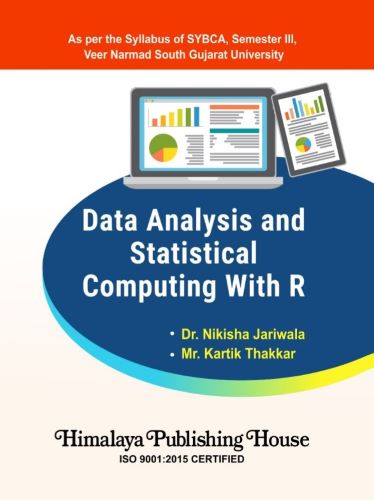Data Analysis and Statistical Computing with R book covers chapters related to the R Programming Language which is very important for Data Analysts and Data Scientists to work on statistical computing and data analysis. It contains all the topics in detail. Each topic contains detailed examples so it becomes easy to understand. By the end of each chapter there is an exercise which helps students to evaluate themselves and they will come to know that which types of questions can be asked. Last chapter of the book contains case studies which covers all the concepts of R programming language in one example. At the end of the book, there are MCQs and Answers which will be helpful to the students in their learning.
Contents –
Chapter 1: Overview of Statistical Computing and Data Analysis
1.1 Importance of Statistics in Computer Science
1.2 Introduction to Statistical Computing
1.3 Introduction to Data Analysis
1.4 How does Statistical Computing Contribute to Data Analysis?
1.5 Which Software are used for Statistical Computing?
Chapter 2: Overview of Statistical Programming Language R
2.1 Introduction to R
2.1.1 Evolution of R
2.1.2 The R Environment
2.2 Significance of Using R
2.2.1 Advantages of R
2.2.2 Disadvantages of R
2.2.3 Applications of R in Real World
2.3 Installation of R
2.4 Using R Language for Data Analysis
2.4.1 R Command Line Tool
2.4.2 Installation and use of RStudio
2.4.3 Using Visual Studio Code
2.4.4 Using Google Colab
Chapter 3: Basics of R Programming Language
3.1 Data Types in R
3.2 R Variables
3.2.1 Methods for Variables
3.2.2 Scope of R Variables
3.3 R Comments
3.4 R Reserved Words
3.5 R Conditional Statements
3.6 R Looping Statements
3.7 R Boolean Statements
3.8 Handling Null, NaN, NA and Inf Values in R
3.9 Built-in Functions
3.9.1 Math Functions
3.9.2 String Literals and Functions
3.10 Escape Characters
3.11 R Operators
3.12 User-defined Function
Chapter 4: Working with Data in R
4.1 Creating Different Data Structures (Vector, Matrix, Data Frame, Array, List, Factor)
4.2 Importing Data (CSV, EXCEL)
4.3 Exporting Data
4.4 Managing Attribute/Column/Variable Names
4.5 Manipulating Data
4.5.1 Subsetting and Filtering
4.5.2 Reordering
4.5.3 Merging and Joining
4.5.4 Reshaping Data (Pivoting and Melting)
Chapter 5: Preprocessing and Data Cleaning
5.1 Overview of Data Cleaning
5.2 Handling Missing Values
5.3 Data Transformation/Formatting
5.4 Type Conversion
5.4.1 Data Type Conversion
5.4.2 Data Structure Conversion
5.5 Handling Categorical and Continuous Data (Recoding)
5.6 Detecting and Handling Outliers
5.7 Data Normalization
Chapter 6: Descriptive Analysis using R
6.1 Measuring Central Tendency (Mean, Median, Mode)
6.2 Dispersion (Range, Variance and Standard Deviation)
6.3 Frequency Distribution and Cross Tabulation (Normal and Binomial)
6.3.1 One-Way Frequency Tables in R
6.3.2 Cross-Tabulation (Summarizing Two or More Categorical Variables)
6.3.3 Three-Way Cross-Tabulation
Chapter 7: Data Visualization using R
7.1 Importance of Data Visualization
7.2 Visualizing Data using Charts
7.3 Basic Plotting in R
7.3.1 Base R Graphics
7.3.2 Visualize Categorical Data (Bar Chart, Pie Chart)
7.3.3 Visualize Numerical Data (Histogram, Density Plot, Boxplot)
7.3.4 Plotting with plotly Package
Chapter 8: Case Study
Multiple Choice Questions






